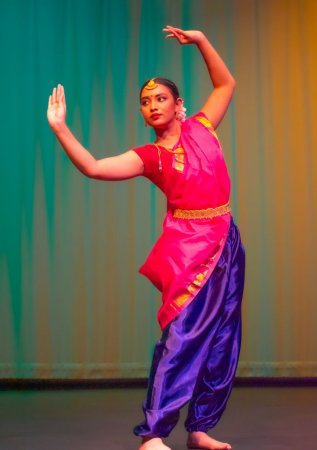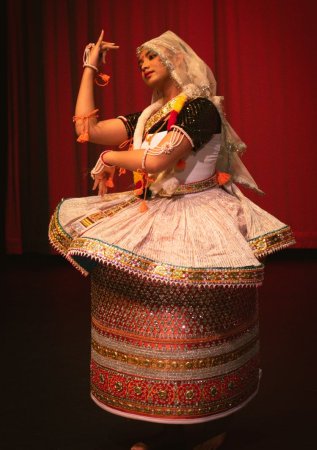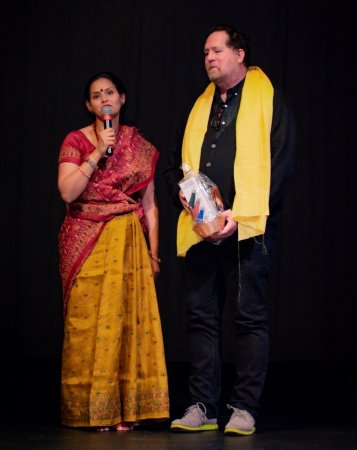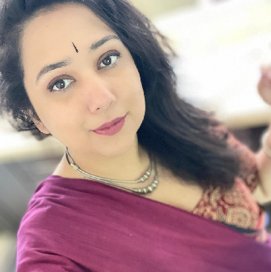
|   |

|   |
Hey Nutan - Tagore, our Light - Sneha Biswas e-mail: snehamuse@gmail.com Photos: Arindam Sanyal October 24, 2024 The Heritage Arts Apprenticeships Program (HAAP), administered by the Center for Washington Cultural Traditions, WA Humanities, and Washington State Arts Commission (ArtsWA), is a prestigious and highly competitive program in Washington state. It supports artists who preserve traditional practices important to their community, heritage, and identity. Sixteen pairs of Washington artists were chosen to preserve traditional skills and knowledge in 2024-2025. Master Artist Piyali Biswas De and Apprentice Tonoya Biswas from Eastlake High School, Sammamish, were selected for the Rabindranritya (Tagore Indian Dance). 'Hey Nutan - Tagore Our Light' is this pair's first public presentation, which took place on September 28, 2024, at Bellevue Youth Theatre, Bellevue, WA. Rabindranritya is a unique dance form that originated in the lap of Bengal in Shantiniketan, developed by Rabindranath Tagore, the first non-European Nobel Literature laureate. He originated this dance form and then brought about an early change and a renaissance in the soil of India. Primarily, this movement of Rabindranritya has been celebrated as an age-old custom and tradition in the heart of Bengal, and the poet laureate created so many songs like lyrical ballads in his Bengali mother tongue that touch upon the essence of God and his almighty presence in the lives of so many netizens around. His songs celebrate the beauty, divinity, light, and joy of the world. Fluid and rhythmic, Rabindranritya blends elements of classical and folk dances and uses graceful movements and poetic gestures to express emotions. This show touches down on those sentiments and has been named "Hey Nutan" for this reason. Paying tribute to the master teacher and performer in the smallest of ways, Tonoya, the high schooler, presented some of her finest pieces. 'Hey, Nutan - Tagore, our light' show has been presented by the pair to ensure that audiences get back to their homes thinking about it as an awareness of Rabindranath's Nritya Shastra. The initiative is to preserve this art form, thus bringing it forth to people with less awareness of it and giving it a voice that Piyali De is most adept at. I was greeted with heartfelt smiles and warmth as I entered the informative Rabindranritya brochures and beautiful Bengal artwork at the entrance. They seemed like Rabindranath Tagore, the Nobel prize winner novelist, author cum writer, and more, greeted me into his world of romance, love, artistry, and seasonal delight. A slow Rabindra Sangeet strain was making its way into my heart as I saw all the artistes on the side of the stage getting busy with tuning. I admired all the lively young musicians like Oishi Sen, Sanchari Paul on vocal, Vikramaadhithyaa Jagannathan on mridangam and tabla, and Nikhil Sai Yammanuru on flute who started the show with a bang. It was a lively, young and vibrant team taking center stage. The live orchestra came to life, mainly composed of the youth and some seasoned singers like Shahnaz Rahman and Anulekha Biswas, who mostly retold Rabindranath Tagore's works to set the show's tone.  Rituranga  Gohono Kushumo Kunjo Majhe Piyali's daughter/disciple Tonoya performed most gracefully. The depiction of all the six seasons, Grishma, Barsha, Sharat, Hemanta, Seet, Boshonto were the central theme around which her dances hovered and where "Rituranga" through live narrations by Tonoya's grandfather Joy Biswas, a seasoned senior recitation artiste, gave us literally goosebumps. Tonoya's performance of the classical and Rabindrik style dance forms were impressive. As the traditional way of narration happened side by side, Tonoya emoted these songs and poems very well, showcasing her best. It embraced Rabindrik dance form, infused with various Indian classical dance styles. She also participated in describing the Lord of Dance, Nataraja in "Nrityero Tale Tale" with intense character and subtle charm, classical Bharatanatyam mudras, and hand movements, gestures, and style. Rarely practiced in the USA currently, a Manipuri dance number, "Gohono Kushumo Kunjo Majhe" performed by Tonoya in Brajabali dialect, a long-lost Indian dialect, was brought back through captivating, enthralling movements. Tonoya had taken master classes from Guru Sanjib Bhattacharya during her summer break. She picked up the dance style quickly and performed it with flair. At the end of it all, we were struck by Piyali De's classical nritya, with Tagore's poems recited brilliantly by Joy Biswas. It was a unique presentation with Tagore's famous poem "Nirjhorer swapno bhango" (The Broken Dream of a Stream) with a background score created by Tonoya with JythonMusic, a Python based environment that allows users to make music and program creatively. Tonoya created music transcription and playback from Jython. This musical score is indeed a bridge where technology meets heritage art.  Piyali De and Thomas Grant Richardson Finally, we had Thomas Grant Richardson, Director at the Centre for Washington Cultural Traditions, on stage. He congratulated all the artists on board, especially Piyali and Tonoya's performances. He explained how competitive this grant is these days, and he's glad Rabindranritya is nurtured with next-generation Indian Americans as a cherished heritage art.  Sneha Biswas is the author of a collection of poems "In the Gossamer of Imagination" and "You and Me, Never Us." She is an educator who teaches English language and literature to youth. She has a graduation degree in English from the Presidency University of Kolkata. Additionally, she pursued a Certificate IV in Media and Communication Studies from TAFE NSW Western Sydney Institute in Australia. As an RFP response writer, she worked for many years as a technical writer at Accenture. |